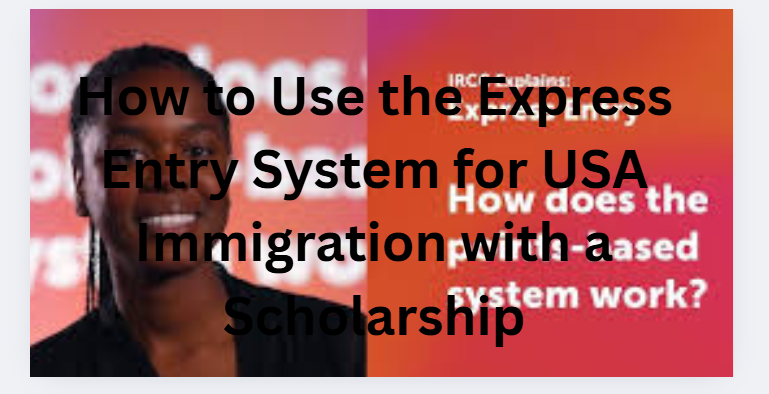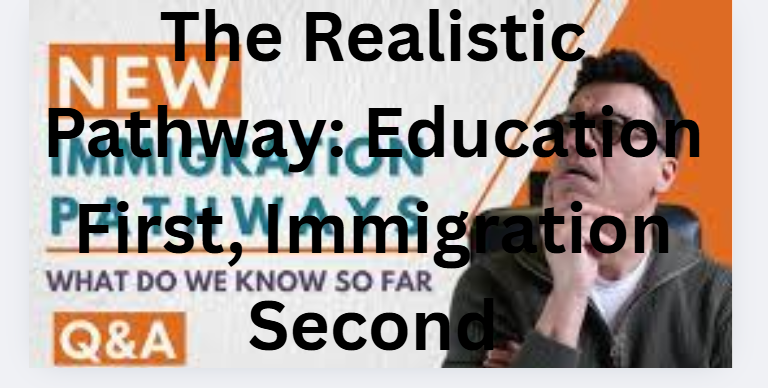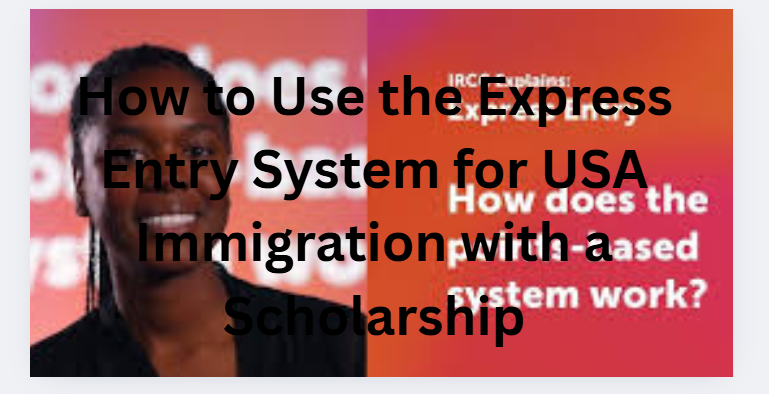
Let’s clear up a common misconception right away: the United States does not have a program called “Express Entry.” That specific name belongs to Canada’s immigration system for skilled workers. This mix-up is understandable, but it’s crucial to know that the US has its own unique, and often more complex, set of immigration pathways.
So, if you’re searching for a way to combine your academic ambitions with a path to living in the US, this article is for you. We will map out the real-world strategies that connect studying in the USA with a scholarship to potential long-term immigration. While there’s no single, straightforward “express” path, understanding how the pieces fit together is the first step toward success.
The Realistic Pathway: Education First, Immigration Second

Unlike systems that directly select immigrants based on a points system, the most common path for students to stay in the US involves a multi-step process. The general idea is to transition from a student visa to a temporary work visa, and then, hopefully, to permanent residency (a Green Card).
Your goal of securing a scholarship is brilliant because it makes the first step—obtaining a world-class education—financially possible. A scholarship doesn’t directly lead to a Green Card, but the education it funds becomes the foundation of your entire American journey.
Why This Education-First Strategy is Effective
Studying in the USA provides you with advantages that are critical for a future immigration case:
- A U.S. Degree: A qualification from an accredited American university is highly valued by U.S. employers, making it much easier to get a job offer.
- Practical Training: After graduation, you are eligible for Optional Practical Training (OPT), which allows you to work in your field for 12 months (or 36 months for STEM degrees). This is your chance to gain crucial U.S. work experience.
- Professional Networks: You will build connections with professors, industry professionals, and potential employers, which can lead to the job offers necessary for the next steps.
Step One: Securing Your U.S. Education and Scholarship
This is the cornerstone of your plan. A significant scholarship makes studying in the U.S. affordable and strengthens your visa application by proving you have substantial financial support.
Finding Scholarships for International Students
Major scholarships for international students are competitive but attainable. Focus your search on these areas:
- University Merit-Based Aid: Many U.S. universities offer substantial merit-based scholarships to attract top-tier international students for undergraduate and graduate programs. These are often awarded based on your academic excellence, test scores, and overall profile. Always check the “Financial Aid” or “International Admissions” section of university websites.
- Program-Specific Funding: Especially at the graduate level (Master’s and PhD), specific departments may have funding, research assistantships, or teaching assistantships that cover tuition and provide a stipend. This is often the most common way graduate students fund their studies.
- Private and Government Scholarships: Some organizations, both in your home country and internationally, offer scholarships for study abroad. Examples include the Fulbright Foreign Student Program, which is a prestigious, highly competitive scholarship funded by the U.S. government.
A strong application is key. Highlight your academic achievements, write compelling essays, secure excellent letters of recommendation, and showcase any unique talents or experiences.
Step Two: Navigating the U.S. Student Visa Process
Once you have your Form I-20 from the university confirming your admission and scholarship, you apply for an F-1 student visa. Your scholarship is a major asset during the visa interview.
You must convincingly demonstrate to the consular officer that you have strong ties to your home country and intend to return after your studies. This is a legal requirement for the F-1 visa. While your long-term goal may be immigration, your immediate intent must be to study.
Step Three: The Bridge from Student to Immigrant
This is the most complex part, where there is no single “Express Entry” system. Your path will depend on your career, employer, and a degree of luck.
The Critical Steps After Graduation
- Optional Practical Training (OPT): After graduating, you apply for OPT. This is a temporary work authorization directly tied to your degree. It gives you one year (or three for STEM fields) to work for any U.S. employer in your field.
- Securing a Job Offer and H-1B Visa: The most common next step is for your employer to sponsor you for an H-1B visa, a work visa for specialty occupations (typically requiring a bachelor’s degree or higher). The challenge? The H-1B is subject to an annual lottery because demand far exceeds the limited number of visas available. This is a significant hurdle.
- Permanent Residency (Green Card): After working on an H-1B, your employer may sponsor you for a Green Card. This is a long, multi-stage process involving labor certification and a visa petition. It can take several years.
How a Scholarship and U.S. Degree Help in This Process
While not a direct ticket, your U.S. education makes every subsequent step easier:
- Winning the Job Offer: A U.S. degree makes you a more attractive candidate to employers, increasing your chances of getting the job offer needed for H-1B sponsorship.
- Navigating the H-1B: The specialized knowledge gained from your degree is essential for qualifying for the H-1B visa category.
- Exploring Other Avenues: A high level of education and achievement might make you eligible for other visa categories that can lead to a Green Card, such as the O-1 visa for individuals with extraordinary ability or the EB-2 National Interest Waiver (where you can self-petition without an employer under specific conditions).
Important Considerations and Alternative Paths
It’s essential to be realistic about the challenges.
- The H-1B Lottery is a Gamble: Your immigration status can become uncertain if you are not selected in the H-1B lottery after your OPT ends. Have a backup plan.
- Employer Dependence: The most common path ties your immigration status to your employer, which can limit job mobility.
- Explore All Options: Some individuals may qualify for family-based sponsorship, the Diversity Visa Lottery, or investor visas (EB-5). However, the student-to-work visa path remains the most common for scholarship recipients.
Final Thoughts: A Strategic Journey, Not an Express Lane
While the United States lacks a system called “Express Entry,” the strategy of using a scholarship-funded education as a springboard for immigration is valid and powerful. It is, however, a marathon, not a sprint. It requires patience, resilience, and careful planning.
Your focus should first be on achieving academic excellence to win a scholarship. That U.S. degree will then open doors to employment opportunities, which in turn create pathways to longer-term stays. By understanding this step-by-step process, you can move beyond the search for a non-existent “Express Entry for the USA” and start building a genuine, strategic plan for your future in America. Start with your studies, and let that investment pave the way for what comes next.
Frequently Asked Questions (FAQs)
1. Does the USA have an “Express Entry” system like Canada?
No, the United States does not have a program called “Express Entry.” This is a common misconception. The U.S. immigration system operates differently, primarily through employer sponsorship, family ties, or specific visa categories. The path for students typically involves moving from a student visa to a work visa and then to permanent residency.
2. Can I get a Green Card directly through a scholarship?
No, a scholarship itself does not lead directly to a Green Card (permanent residency). However, a scholarship enables you to study in the U.S., which can be the first step in a longer process. The U.S. degree and subsequent work experience you gain make you eligible for visas that can eventually lead to a Green Card.
3. How does a scholarship help with U.S. immigration?
A scholarship helps in two key ways:
- It makes studying in the U.S. financially possible, allowing you to earn a valuable U.S. degree.
- It strengthens your F-1 student visa application by proving you have serious financial support.
The U.S. education you receive is what ultimately helps your immigration case by making you more attractive to employers who can sponsor your work visa.
